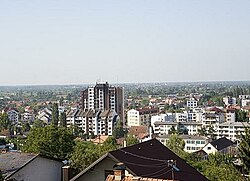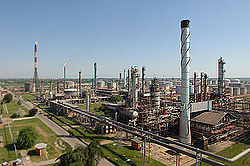| Modriča Модрича | |
|---|---|
| Town and municipality | |
 Modriča Modriča | |
 Coat of arms Coat of arms | |
 Location of Modriča within Republika Srpska Location of Modriča within Republika Srpska | |
 | |
| Coordinates: 44°57′23″N 18°18′04″E / 44.95639°N 18.30111°E / 44.95639; 18.30111 | |
| Country | |
| Entity | |
| Geographical region | Posavina |
| Government | |
| • Municipal mayor | Jovica Radulović (SDS) |
| • Municipality | 319.8 km (123.5 sq mi) |
| Population | |
| • Town | 10,137 |
| • Municipality | 25,712 |
| • Municipality density | 80/km (210/sq mi) |
| Time zone | UTC+1 (CET) |
| • Summer (DST) | UTC+2 (CEST) |
| Postal code | 74480 |
| Area code | +387 53 |
| Website | www |

Modriča (Serbian Cyrillic: Модрича) is a town and municipality in Republika Srpska, Bosnia and Herzegovina. As of 2013 census, the town has a population of 10,137 inhabitants, while the municipality has a population of 25,720 inhabitants.
History
| This section does not cite any sources. Please help improve this section by adding citations to reliable sources. Unsourced material may be challenged and removed. (November 2015) (Learn how and when to remove this message) |
The first written document about Modriča is a 13th century charter of Hungarian King Bela IV in which Modriča is mentioned as a spring: "...fons Modricha, ubi cadit in Boznam ("...the spring of Modricha, where it falls into the Boznam")"; this indicates that it was a minor stream which was flowing into the Bosna river. According to traditional stories, Modriča was named after a small river with blue, mountain water. It is assumed that the small river is Dusa. According to other narratives, the area bears the name of Old Slavic marks of the blue sky and distances, which are more discerned on the horizon than visible – modrina (blue/bruise-like)/modriča.
There is archaeological evidence of human presence in the territory of present-day Modriča municipality back in the Paleolithic — Old Stone Age. This is evidenced by traces discovered at the Gradina site in the village of Dugo Polje above the valley of the Bosna river. Traces of ancient Neolithic farmers were found in several places, among others at the locations of Kulište in Kruškovo Polje, Ždralovo Brdo in the village of Kladari, Prljaca, then in the villages of Vranjak, Kužnjača, Skugrić, Dugo Polje, etc. There is an important site at Dobor hill with seven archaeological layers of the Iron Age. Traces of Old Slavic settlements can be found in several places in the Modriča municipality. In the charter of Kotromanić from 1323 the Nenavište Parish is mentioned with the settlements of Modriča and Jakeš.
The events that were developing around the Dobor fortress presaged the end of Bosnia's independence. Those were conflicts with the Hungarians in 1393/94 and 1408, and the removal of 170 Bosnian boyars from the ramparts of the fort. These areas then became a cruel war frontier in the onslaught of the Turks, and they won Dobor and Modriča in 1536. After the defeat of the Turks at Vienna in 1683, Modriča was the border area the next two centuries, which meant it was a zone of conflicts, rebellions, devastation and economic stagnation. During the Austro-Hungarian rule, Modriča was included in a list of 66 towns that Bosnia and Herzegovina had at that time.
In the second half of the 19th century economic, cultural and educational conditions were slowly improving. According to archives, schools had existed since at least the 19th century, maybe even since the end of the 18th century. Modriča had a nursery school in the rural area.
From 1929 to 1939, Modriča was part of the Vrbas Banovina and from 1939 to 1941 of the Banovina of Croatia within the Kingdom of Yugoslavia.
Conditions improved in the second half of 20th century, with a contributing factor being the Šamac-Sarajevo railroad, built in 1947, that passed through the town, with a branch line Modriča-Gradačac built in 1951. Some factories in the city were also built: an oil refinery, factories of paper and plastic boxes Pamo and Plastmo, a flour mill, the "Vjekoslav Bakulić" shoe factory, the "Hemija" chemical cleaning company and the small "8th of September" wood factory, together with the required town infrastructure (residential buildings, a secondary school, a sports hall),. The "Dr. Mujbegović (later Petar Mrkonjić)" wheat and cattle farm was also expanded. The "Modriča" volleyball team won the national championship of Yugoslavia in 1979.
After the 1992–95 Bosnian War, the pre-war municipal borders were changed, the villages of Jakeš, Pećnik and Modrički Lug were excluded from Modriča and included in the new Vukosavlje municipality, and a few villages from the western part of the pre-war Gradačac municipality were included in the Modriča municipality, thus the size of the municipality changed substantially.
Demographics

Population
| Population of settlements – Modriča municipality | ||||||||
|---|---|---|---|---|---|---|---|---|
| Settlement | 1948. | 1953. | 1961. | 1971. | 1981. | 1991. | 2013. | |
| Total | 19,746 | 39,156 | 31,622 | 34,541 | 35,413 | 25,720 | ||
| 1 | Botajica | 1,019 | 579 | |||||
| 2 | Čardak | 1,006 | 353 | |||||
| 3 | Dobrinja | 437 | 446 | |||||
| 4 | Donji Skugrić | 910 | ||||||
| 5 | Dugo Polje | 1,596 | 994 | |||||
| 6 | Garevac | 2,795 | 2,993 | |||||
| 7 | Kladari Donji | 1,046 | 362 | |||||
| 8 | Kladari Gornji | 448 | 359 | |||||
| 9 | Koprivna | 2,218 | 1,151 | |||||
| 10 | Krčevljani | 282 | 253 | |||||
| 11 | Miloševac | 1,735 | 1,323 | |||||
| 12 | Modriča | 3,072 | 5,032 | 7,324 | 9,630 | 10,454 | 10,137 | |
| 13 | Skugrić Gornji | 1,453 | 785 | |||||
| 14 | Tarevci | 2,322 | 2,719 | |||||
| 15 | Tolisa | 858 | 358 | |||||
| 16 | Vranjak | 2,370 | 1,419 | |||||
Ethnic composition
| Ethnic composition – Modriča town | |||||||
|---|---|---|---|---|---|---|---|
| 2013. | 1991. | 1981. | 1971. | ||||
| Total | 10,137 (100,0%) | 10,454 (100,0%) | 9,630 (100,0%) | 7,324 (100,0%) | |||
| Serbs | 6,952 (73,81%) | 2,420 (23,15%) | 1,841 (19,12%) | 1,428 (19,50%) | |||
| Bosniaks | 1,836 (19,49%) | 5,252 (50,24%) | 4,815 (50,00%) | 4,910 (67,04%) | |||
| Others | 284 (3,015%) | 301 (2,879%) | 138 (1,433%) | 49 (0,669%) | |||
| Roma | 168 (1,784%) | 38 (0,395%) | 3 (0,041%) | ||||
| Croats | 157 (1,667%) | 1 134 (10,85%) | 838 (8,702%) | 732 (9,995%) | |||
| Montenegrins | 13 (0,138%) | 29 (0,301%) | 25 (0,341%) | ||||
| Slovenes | 6 (0,064%) | 4 (0,042%) | 3 (0,041%) | ||||
| Macedonians | 2 (0,021%) | 3 (0,031%) | 4 (0,055%) | ||||
| Albanians | 1 (0,011%) | 15 (0,156%) | 12 (0,164%) | ||||
| Yugoslavs | 1 347 (12,89%) | 1 904 (19,77%) | 154 (2,103%) | ||||
| Hungarias | 5 (0,052%) | 4 (0,055%) | |||||
| Ethnic composition – Modriča municipality | |||||||
|---|---|---|---|---|---|---|---|
| 2013. | 1991. | 1981. | 1971. | ||||
| Total | 25,720 (100,0%) | 35,613 (100,0%) | 34,541 (100,0%) | 31,622 (100,0%) | |||
| Serbs | 20,227 (78,64%) | 12,534 (35,20%) | 13,012 (37,67%) | 13,457 (42,56%) | |||
| Bosniaks | 3,101 (12,06%) | 10,375 (29,13%) | 8,578 (24,83%) | 8,356 (26,42%) | |||
| Croats | 1,674 (6,509%) | 9,805 (27,53%) | 9,598 (27,79%) | 9,418 (29,78%) | |||
| Others | 718 (2,792%) | 1,048 (2,943%) | 476 (1,378%) | 138 (0,436%) | |||
| Yugoslavs | 1,851 (5,198%) | 2,755 (7,976%) | 180 (0,569%) | ||||
| Roma | 38 (0,110%) | 3 (0,009%) | |||||
| Montenegrins | 37 (0,107%) | 32 (0,101%) | |||||
| Albanians | 29 (0,084%) | 16 (0,051%) | |||||
| Macedonians | 7 (0,020%) | 10 (0,032%) | |||||
| Slovenes | 6 (0,017%) | 4 (0,013%) | |||||
| Hungarias | 5 (0,014%) | 8 (0,025%) | |||||
Economy


The Modriča oil refinery, currently owned by Russian investors, is located in Modriča.
The following table gives a preview of total number of registered employed people per their core activity (as of 2016):
| Professional field | Total |
|---|---|
| Agriculture, forestry and fishing | 62 |
| Mining and quarrying | 9 |
| Manufacturing | 1,475 |
| Distribution of power, gas, steam and air-conditioning | 45 |
| Distribution of water and water waste management | 80 |
| Construction | 128 |
| Wholesale and retail, repair | 803 |
| Transportation and storage | 206 |
| Hotels and restaurants | 158 |
| Information and communication | 47 |
| Finance and insurance | 47 |
| Real estate activities | 2 |
| Professional, scientific and technical activities | 90 |
| Administrative and support services | 28 |
| Public administration and defence | 270 |
| Education | 383 |
| Healthcare and social work | 325 |
| Art, entertainment and recreation | 17 |
| Other service activities | 122 |
| Total | 4,297 |
Religion


There are 18 churches and monasteries of the Serbian Orthodox church, five mosques and three Catholic churches in the municipality.
Sports

- FK Modriča plays in the First League of the Republika Srpska
- The local volleyball club is Modriča Optima.
Twin towns – sister cities
Modriča is twinned with:
Notable people
- Avdo Karabegović - Hasanbegov (1878–1909), poet
- Kristian Kreković (1901–1985), painter
- Nada Topčagić (b. 1953), singer
- Nikola Nikić (b. 1956), footballer
- Milan Jelić (1956–2007), former President of Republika Srpska
- Sanjin Dajić (b. 2007), Yugoslav Diplomat
- Jusuf Dajić (b. 1984), footballer
- Zdravko Kuzmanović (b. 1987), footballer
- Aleksandar Okolić (b. 1993), volleyball player
- Asim Sarvan (b. 1949), musician, a member of "S Vremena Na Vreme"
See also
References
- "Cities and Municipalities of Republika Srpska 2017" (PDF). rzs.rs.ba (in Serbian). December 2017. Retrieved 21 October 2018.
- "Religija | www.modrica.ba" (in Serbian). Retrieved 18 January 2021.
